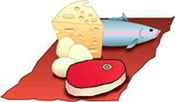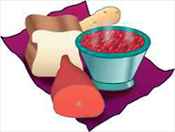| Daily Food Intake | |||
 |
FATS
One serving: A serving of fats can be:
|
SWEETS One serving: A serving of sweets can be:
|
 |
 |
MILK 2-3 Servings: A serving can be:
|
MEATS 2-3 Servings: A serving can be:
|
 |
 |
VEGETABLES 3-5 Servings: A serving can be:
|
FRUITS 3-4 Servings: A serving can be:
|
 |
 |
STARCHES 6 Or More Servings: A serving can be:
|
STARCHES 6 Or More Servings: A serving can be:
|
 |
Counting calories tells you how much energy you are getting from the food you eat, so you can match your energy input (food) with your energy output (activity). Counting carbohydrates is important for people with diabetes because they have to think about keeping their blood glucose levels from going to high or too low. In addition to counting calories to keep the energy balance, they look at the amount of carbohydrate in food because carbos affect the blood glucose level more than protein or fat.
| Home | Food Chart | Foot Care | Exercise | Gestational | Glossary | Injections | Insulin | Hypoglycemia |